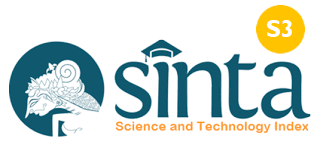Nilai-Nilai Pendidikan Karakter Religious Pada Geguritan Pan Balang Tamak
Keywords:
Education; Character; Religious;, Geguritan; Pan Balang TamakAbstract
To create a great nation, it is not enough to have abundant natural resources and intelligent human resources. The most important thing in building a nation is to have people with character. If the nation's children have intelligence but do not have good character then all of that will be in vain. Education has a goal to educate and shape people with character, especially religious characters. This article aims to examine the values of religious character education in Geguritan Pan Balang Tamak which is carried out through discourse analysis. The values of religious character education found in Geguritan Pan Balang Tamak are Satya Hredaya, Believe in Atman, Believe in death, Believe in Hyang Widhi (Brahman), and observant in praying. Through Geguritan Pan Balang Tamak, people learn religious characters so that in everyday life they can apply Hindu teachings. The contribution of this article is that all Hindus are always obedient to preserve and learn the arts and culture that have been inherited by their ancestors and all of that is also in accordance with the wishes of Hindus in Bali, especially to carry out a steady Bali.
References
Antara. (2021). Jual Vaksin Covid-19 Secara Ilegal, 2 Dokter di Medan Raup Untung Rp 238 Juta. Tempo.Co, 1.
Anugrahadi, A. (2021). Viral Pengemudi Pelat B Maki-Maki Polisi Tak Terima Disekat di Perbatasan Sukabumi. Liputan6.Com, 1.
Berkowitz, M. W., & Bier, M. C. (2004). Research-Based Character Education. The ANNALS of The American Academy of Political and Social Science, 591(1), 72–85. https://doi.org/https://doi.org/10.1177/0002716203260082
Dewantara, K. . (2004). Pendidikan (Pertama). Majelis Luhur Persatuan Taman Siswa.
Durkheim, E. (2011). The Elementary Forms Of The Religious Life (E. A. . Iyubenu & A. Fahrudin (Eds.); Baru). IRCiSoD.
Maswinara, I. W. (1999). Sistem Filsafat Hindu (Sarva DarsanaSamgraha). Paramita.
Nasution, I. (2021). Polisi Tangkap Wanita yang Maki Petugas saat Diputar Balik di Anyer. OkeNews, 1.
O’Callaghan, P. (2017). Cultural Challenges to Faith: A Reflection on the Dynamics of Modernity. Journal Church, Communication and Culture, 2(1), 25–40. https://doi.org/10.1080/23753234.2017.1287281
O’neil, W. F. (2008). Ideologi-ideologi Pendidikan. Pustaka Pelajar.
Pals, D. L. (1996). Seven Theories Of Religion (1st ed.). Oxford University Press.
Peraturan Pemerintah Republik Indonesia Nomor 57 Tahun 2021 Tentang Standar Nasional Pendidikan, Pub. L. No. NOMOR 57 TAHUN 2021, 14 (2021).
Peterson, A. (2020). Character Education, the Individual and the Political. Journal of Moral Education, 49(2), 14. https://doi.org/0.1080/03057240.
Prabhupada, S. (2010). Srimad Bhagavatam (Bhagavata Purana) Skanda Empat Jilid 3. Hanuman Sakti.
Pudja, G. (2004). Bhagavad Gita (I. W. Maswinara (Ed.); Pertama). Paramita. http://www.paramitapublisher.com
Radhakrishnan, S., & Mantik, A. S. (2008). The Principal Upanisads (Pertama). Paramita. http://www.paramitapublisher.com
Saiful. (2013). Filsafat Idealisme Dan Realisme: Suatu Perspektif Pendidikan. Jurnal Mentari: Jurnal Ilmiah Ilmu-Ilmu Humaniora, 16(2), 12. https://ejournal.unmuha.ac.id/index.php/mentari/article/view/130
Sivananda, S. S. (2003). All About Hinduism (Revisi). Paramita.
Sudiani, N. N. (2015). Pendidikan Karakter Melalui Gending Rare Studi Etnografi Pada Anak Usia Dini Di Desa Adat Tenganan Pegringsingan, Kabupaten Karangasem, Provinsi Bali (2013). Jurnal Pendidikan Anak Usia Dini, 9(1), 51–74. https://doi.org/10.21009/JPUD.091.04
Sudiani, N. N. (2017). Pedanda Baka Story As Media Of Character Education Since Early Childhood. Vidyottama Sanatana: International Journal of Hindu Science and Religious Studies, 1(1), 8.
Suprapta, I. N. (2015). Pan Balang Tamak. Sanggar Sunari.
Temiz, N. (2019). A Lesson Plan Model for Character Education in Primary Education. Academic Journals Educational Research and Reviews, 14(4), 130–139. https://doi.org/10.5897/ERR2018.3616
Triguna, I. Y. (2018). Konsep Ketuhanan Dan Kemanusiaan Dalam Hindu. Jurnal Dharmasmrti, I(18), 71–83. https://media.neliti.com/media/publications/266366-konsep-ketuhanan-dan-kemanusiaan-dalam-h-3b6e828b.pdf
Ubani, M., & Keränen-Pantsu, R. (2018). Evolving Cultures of Religious Education: New Perspectives on Research, Policies and Practices. Journal of Beliefs & Values Studies in Religion & Education, 39(2), 127–131. https://doi.org/10.1080/13617672.2018.1472894
Undang-Undang Sistem Pendidikan Nasional (Nopember). (2010). Fokusmedia. www.fokusmedia.co.id
Vireśvarānanda, S. (2002). Brahma Sūtra Pengetahuan tentang Ketuhanan. Paramita.
Downloads
Published
How to Cite
Issue
Section
License
An author who publishes in the Cetta : Jurnal Ilmu Pendidikan agrees to the following terms:
- Author retains the copyright and grants the journal the right of first publication of the work simultaneously licensed under the Creative Commons Attribution-ShareAlike 4.0 License that allows others to share the work with an acknowledgement of the work's authorship and initial publication in this journal
- Author is able to enter into separate, additional contractual arrangements for the non-exclusive distribution of the journal's published version of the work (e.g., post it to an institutional repository or publish it in a book) with the acknowledgement of its initial publication in this journal.
- Author is permitted and encouraged to post his/her work online (e.g., in institutional repositories or on their website) prior to and during the submission process, as it can lead to productive exchanges, as well as earlier and greater citation of the published work (See The Effect of Open Access).
Read more about the Creative Commons Attribution-ShareAlike 4.0 Licence here: https://creativecommons.org/licenses/by-sa/4.0/.





